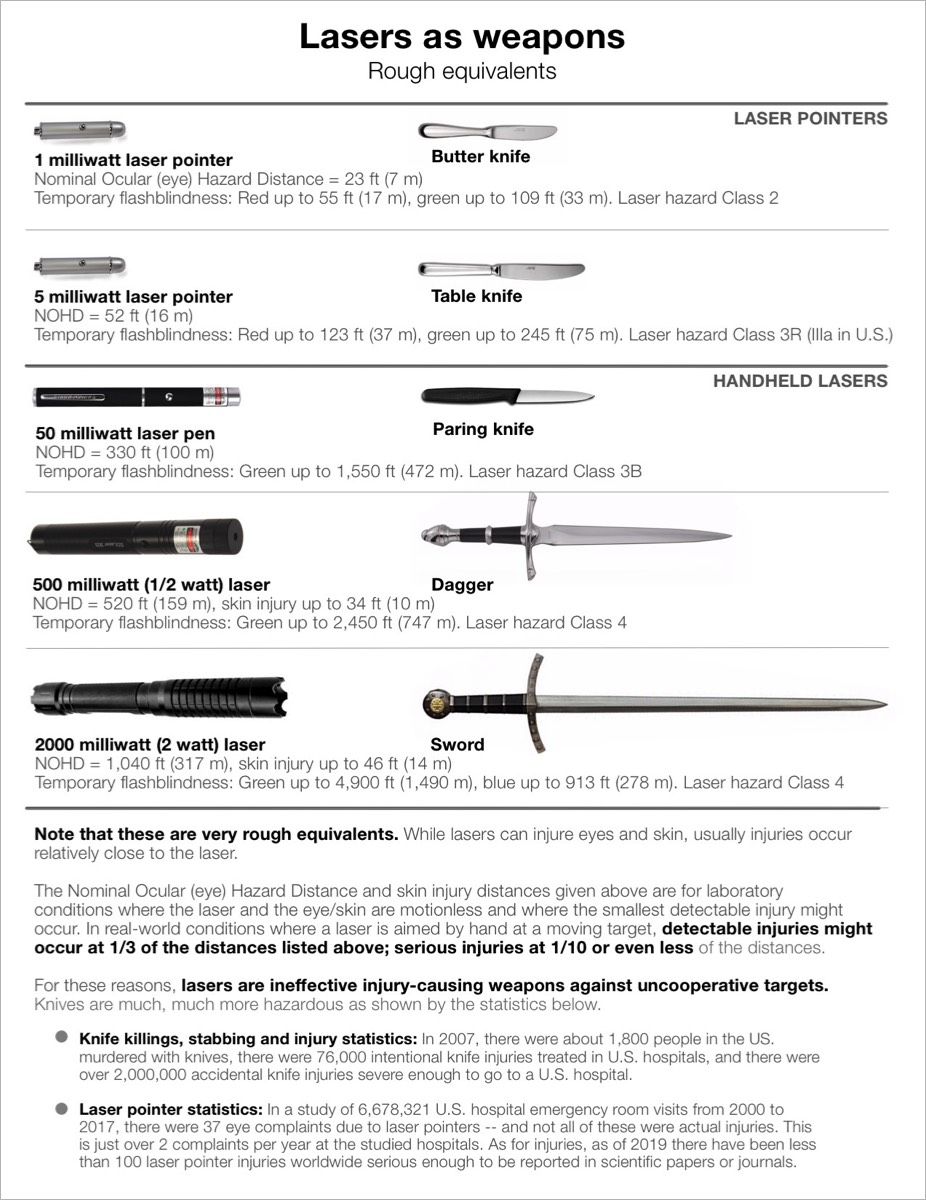Home
A comprehensive resource for safe and responsible laser use
Laser pointer use during protests
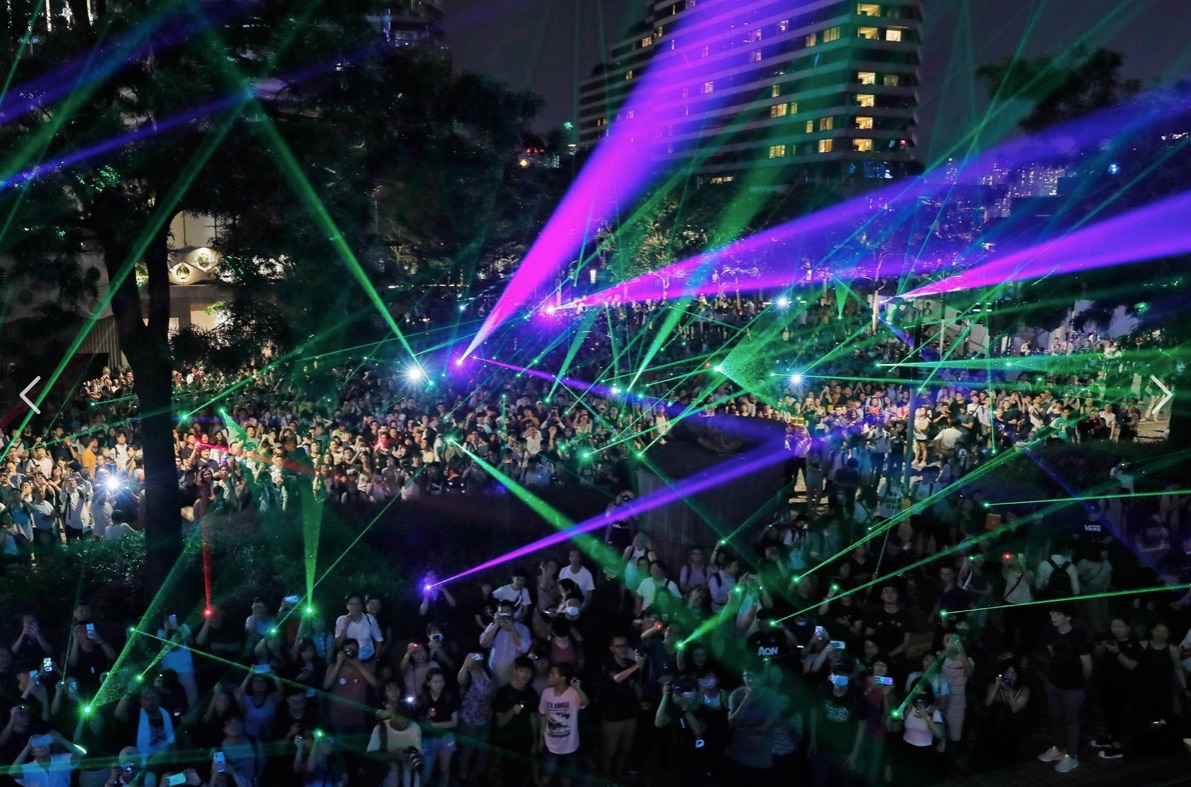
Summary of this topic
-
Summary - key points
- Lasers are used at protests both for intentional interference with law enforcement officers and cameras, and for non-interfering attention-drawing which is the visual equivalent of shouting or waving signs and banners.
- A laser beam aimed into a person's eyes can cause temporary flashblindness, the same as if a camera flash goes off in their eyes. If the flash is bright, an afterimage can last a long time. But an afterimage is NOT an injury, by definition.
- It is very difficult — nearly impossible — for a protester to cause a serious or permanent eye injury (retinal burn) with even a powerful handheld laser at a distance of many yards from an uncooperative officer who blinks or turns away. Some reasons for this are discussed in the section below "Use and misuse of the NOHD to determine laser hazard distances" and in the section "Reasons why pilot eye injuries are unlikely" on the Laser Hazards to Aviation page.
- As of September 1 2020, we are not aware of any proven cases of serious or permanent eye injuries to officers due to laser use at protests. Any claim of a serious or permanent eye injury should be met with extreme skepticism until proven by one or more specialists in laser eye injuries. This is in part because pre-existing eye conditions may be mistaken for laser-caused injuries, especially when the examiner is not a specialist in laser eye injuries. Also, be wary of claims of "eye injury" that turn out to be temporary, regular flashblindness like that from a camera flash. (In July 2020 a Los Angeles police officer on a routine call — non-protest — suffered an apparently serious eye injury, along with other effects as described here.)
- Anyone illuminated by a laser who is concerned about eye injuries or aftereffects, should read the page "If you are hit by a laser beam."
- Ordinary citizens, police, and other non-laser experts should never deliberately aim a laser at a person's head or eyes. The risk of injury depends on many factors, such as the laser power, divergence (beam spread), distance, steadiness, etc. Because non-experts cannot fully evaluate the risk, it is safest and most humane to keep a laser beam well away from anyone's head and eyes.
- The best strategy for law enforcement is to equip some or all officers at protests with anti-laser visor strips or laser protective eyewear. Sources are listed below in the section "How to defend against laser attacks." The strips or glasses will allow normal operation when faced with laser beams. Then, this must be followed up with active detention or arrests of persons who aim lasers at officers' heads or eyes. This two-part strategy has been found to drastically reduce or stop laser misuse at protests. Those misusing lasers know there is a high likelihood of being detained or arrested. (There should not be indiscriminate arrests of anyone at a protest with a laser, or of persons waving laser beams around to call attention at a protest, such as in the photo at the top of this page. These uses do not interfere with law enforcement.)
- Restricting access to laser pointers or banning them will not significantly reduce or stop misuse at protests or elsewhere (such as aiming at aircraft), at least not in the near term meaning the next 5-10 years. Countries such as Australia and New Zealand tried this, and laser misuse actually rose after bans. There are many reasons that bans haven't worked, detailed elsewhere.
- It may be a legitimate law enforcement technique to temporarily prohibit laser possession at specified protests or locations, similar to curfews. A "laser curfew" would be a broad infringement of rights … but then again a regular curfew is also a broad infringement of rights which is legally accepted and which can be situationally useful. (In November 2020, Los Angeles added lasers of any type and power to a list of items prohibited at demonstrations.)
- Anyone genuinely concerned about preventing eye injuries at protests should concentrate not only on potential laser light effects on law enforcement officers, but even more on the dozens and hundreds of actual eye distress, injuries, and gruesome blindings inflicted on protesters, journalists and bystanders worldwide when rubber bullets, lead pellets, gasses and sprays are used. To give one example, the American Academy of Ophthalmology called for a ban on rubber bullets after more than 20 serious or permanent eye injuries to U.S. protesters in May-June 2020. More examples are here.
Why lasers are used at protests
- Aiming at authorities to distract or temporarily flashblind them. This might be done to disrupt the authorities' view of the people in front of them (e.g., those holding the lasers). Or it could be more planned, as a diversion to draw authorities' attention from another area of the protest.
- Aiming at counterprotesters for similar disruptive or attacking reasons. In March 2021, police said protesters in Salem, Oregon were aiming lasers at passing cars, apparently driven by opposing protesters. An 18-year-old was charged with five counts of unlawful pointing of a laser.
- Aiming at camera sensors to temporarily flashblind, or permanently disable cameras. This was done in the August 2019 Hong Kong protests to try and shut down facial recognition systems used against protesters. This is much more difficult than it may seem, according to a September 2019 study discussed at the bottom of this page in the gray topic "Surveillance cameras easily damaged by lasers, but are harder to fully obscure."
- Aiming at buildings, helicopters, crowds, etc. to gain attention. This is the visual equivalent of shouting or chanting. There is no intent to harm or do anything other than to express displeasure against a target such as a police station, or to gain attention for the protest. (Of course, aiming lasers at people and aircraft is potentially hazardous and thus may have unintended consequences.)
- Aiming at authorities to try to inflict eye or skin injuries. Powerful handheld lasers may cause eye injuries at close range. However, serious or permanent injuries do not generally occur for reasons discussed elsewhere on this page. (Be wary of any official accounts of eye injuries. They may not be accurate unless the patient has been assessed by an expert with experience in laser eye injuries.) As for skin injuries, usually handheld lasers are not powerful enough to injure uncooperative persons' bare skin at any reasonable distance. Also, the person will feel the heat build up and should be able to move or turn away before any significant burn occurs.
How to defend against laser attacks
- Persons directly illuminated by laser beams can blink, look down or look away. This reduces the amount of time the laser is in the eye and thus reduces any heat buildup. (Injuries from visible laser light are possible when the eye's lens focuses the light onto the retina. Whether an actual injury occurs depends on the power of the laser and the length of time it is in any one place on the retina. Also, by looking away, if there is an injury it would not be in the center of the visual field which is most important for good vision.)
- Helmet shields can be equipped with tinted laser-absorbing strips that reduce the laser's brightness. Standard strips are effective against the most common laser colors used at protests, such as green at 532 nm and blue/violet at 445 nm. Custom strips can be made to protect against additional wavelengths. An advantage of the strip is that the wearer just tilts his or her head down so they are looking out the strip. Nothing needs to be put on as is the case with glasses. Photos and a description of such a laser-absorbing strip are at a news story here. Sources for laser-absorbing strips: One source is Laser Optical Engineering Ltd. in the U.K. Pricing is £25 (USD $32) per strip in low quantities (<200). According to the manufacturer, in field use it was found that direct attacks on police "stopped quickly" once protesters knew their lasers were ineffective and that laser attackers would be identified and arrested. A similar strip of protective film, 1" x 9", is sold in sample quantitites for USD $25 by Kentek. In October 2020, Colorado company Super Seer announced their Lazer-Shield strip. Other companies which sell laser protective eyewear may have their own versions.
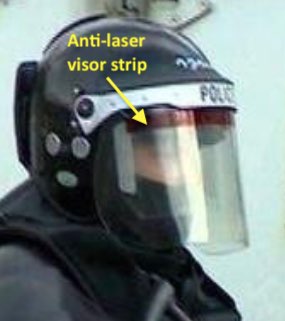
- Laser glare protection eyewear may be used by pilots or others facing constant laser harassment, who need to protect a full visual field (not just a strip). Some police air services and demonstration officers have been issued such anti-laser glasses. For example, Laser Optical Engineering Ltd. makes anti-dazzle glasses for police use. Pricing is £50 (USD $64) each in low quantities (<50). A July 10 2020 sole-source contract saw the Federal Protection Service buying Stingerhawk FT-2 Laser Protective Eyewear from Revision Military. The contract's expected cost was $125 for each pair, in quantity of 1,000 pairs. Additional companies that make anti-laser glasses are listed on this page which is about pilot eyewear; these companies also make eyewear for protection at protests.
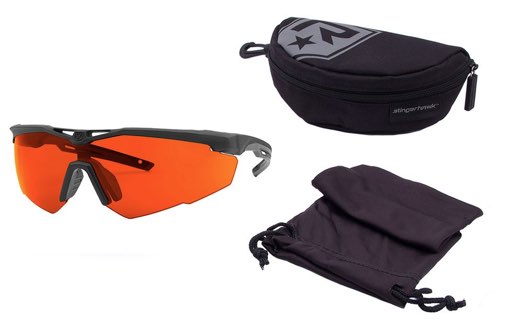
According to the contract document, this is why FPS authorized sole-source purchasing of 1,000 Stingerhawk FT-2 glasses: "While several manufacturers make lenses that defeat the effects of these lasers specifically designed for Law Enforcement and aviators; the Revision FT-2 Laser Protective Eyewear model provides a broader laser protection to include protection from Green, Blue and Violet laser light. The FT-2 has adequate visible light transmission and FPS has also had reports of violet laser use during these demonstrations creating the need for the broader protection. Revision Hawk was the provider of the rest of FPS head gear; therefore, the Revision Hawk Stingerhawk FT-2 Eyewear is made to to works with the helmets that FPS utilizes. The Stingerhawk FT-2 Laser Protective Eyewear provide the needed protection for the laser wavelength of concern, the feature wrap around protection and ballistic protection required for law enforcement operations. Market Research shows that there are no distributors of the lens; they are only available from the manufacturer."
- Laser-wielding demonstrators generally can be easily identified. The visible laser beam points right back to the person holding it. Police can counter in real-time (arrest) or can use photos/video to later try to apprehend laser attackers.
- Police can use bright light as well. In the August 2019 protests, the Hong Kong Journalists' Association accused police of aiming "strong flashlights" at journalists to obstruct their reporting.
Lasers at protests are unlikely to cause eye injuries
In terms of causing eye injuries to police, in general lasers are not effective. Even if a person wanted to cause an injury, it is hard to do so by handholding a low-power laser beam on an uncooperative person many yards or meters away who can close his or her eyes, or who can simply look away.
Authorities or the press may try to indicate these are dangerous weapons. During the August 2019 Hong Kong protests, police held a press conference where they showed a laser at a close range (roughly 20 inches or 1/2 meter) being steadily aimed at a motionless sheet of newspaper:
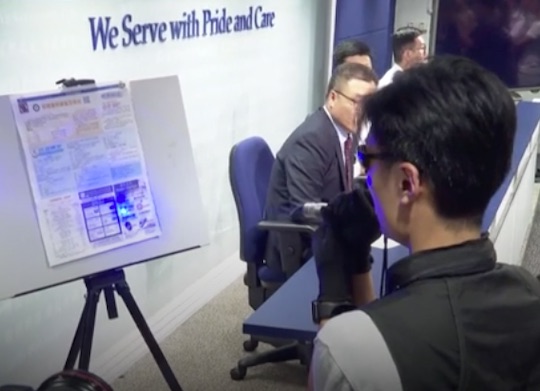
After a few seconds of being held on a dark (light-absorbing) part of the newspaper, smoke appeared:
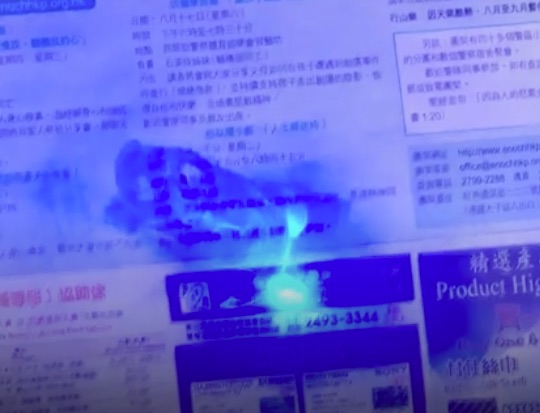
However, in real-world protest conditions it is much less likely the laser could burn the paper. At longer distances such as from a protester to a police officer it is harder to keep the laser on a single spot so that heat builds up. The target can blink or move. The beam spreads as it travels, lessening the light energy density (a larger beam "dot").
To counteract the police claims, a protester held up a newspaper while dozens of lasers tried to burn it — "without success" according to a news story.
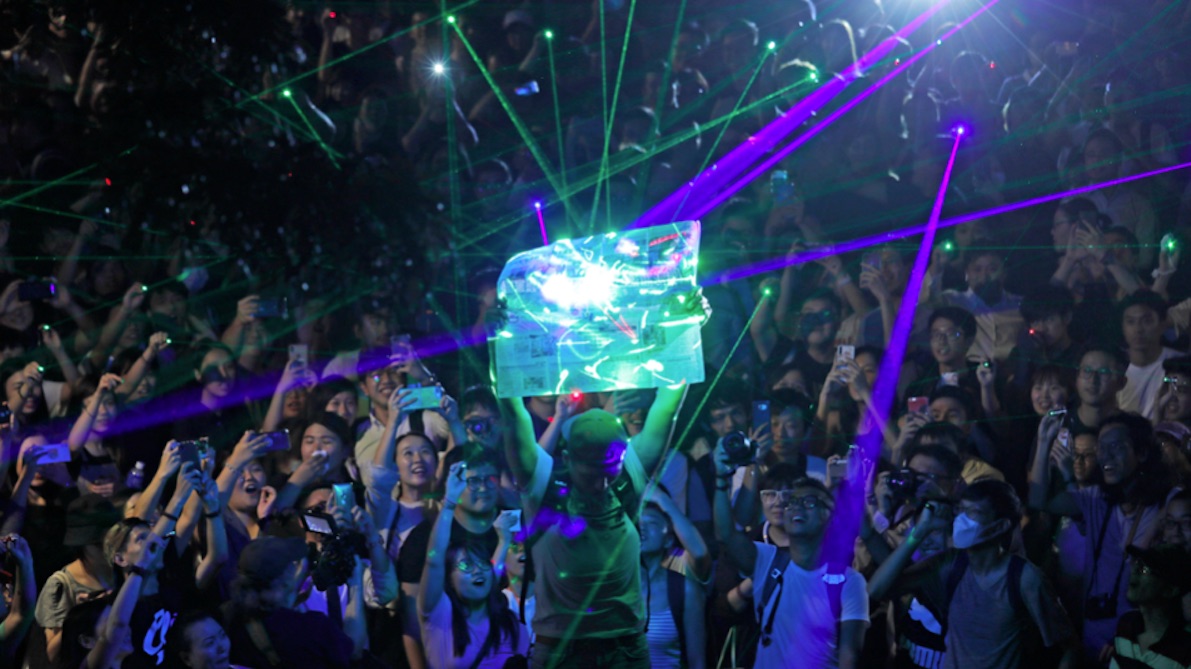
This is not to say that laser light is completely safe, or that it should be deliberately aimed at anyone's head. Ordinary citizens, police, and other non-laser experts should never deliberately aim a laser at a person's head or eyes. The risk of injury depends on many factors, such as the laser power, divergence (beam spread), distance, steadiness, etc. Because non-experts cannot fully evaluate the risk, it is safest and most humane to keep a laser beam well away from anyone's head and eyes.
Hong Kong police did claim potential injuries. They said "three of our officers received medical treatment after protesters shined laser guns at them." The nature of any injury was not reported.
In mid-July 2020, there were claims of potentially permanent eye injuries from protesters in Portland, Oregon. On July 21 2020, a U.S. Federal Protective Service spokesperson said "We have three officers who currently have eye injuries and they may not recover sight in those eyes from those laser attacks". The assertion was widely repeated by officials and the press. But it appears to be untrue. On August 4 2020 a federal official testified that there were 113 eye injuries during the Portland protests — none permanent: "We've had a number of officers who had days-long blindness. So far, they've all kind of come back, if you will." If there had been serious, permanent eye injuries they would have been mentioned during the official's testimony.
There is a report of a serious eye injury to a Los Angeles police officer during a routine call (not at a protest) in July 2020. The officer was targeted by a laser aimed from a fourth-floor apartment, apparently unrelated to the original call. He reported lost vision in his right eye, migraines and balance issues for at least two months after the attack. It is not known whether the injury would be permanent. Details are here.
A January 21 2021 news story quoted a South Dakota police officer who "said he talked with a Washington, D.C., police officer whose eyes were damaged by a protester using a laser. The officer was taken to the hospital, saw multiple eye doctors over two weeks and still suffers from adjusting to changes in the light. He said the pain felt like a sunburn on his eyeballs." It is not known when the eye injuries occurred, whether they were to the cornea (caused by rubbing too hard) or to the retina (caused by laser light), and what the long-term prognosis is.
Anyone illuminated by a laser who is concerned about eye injuries or aftereffects, should read the page "If you are hit by a laser beam."
Lasers can block or damage cameras
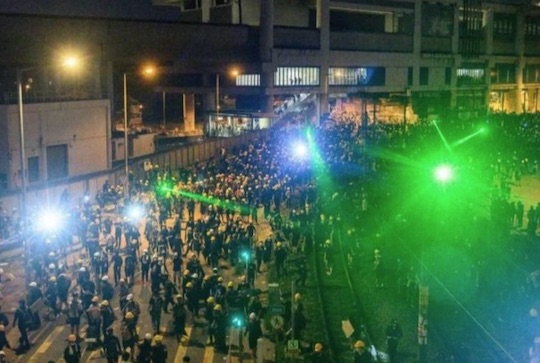
For blocking the view to be effective, the laser's light would need to stay on the camera lens. In most cases, as soon as the laser is taken away, the view returns.
If the laser is powerful enough, the sensor can be damaged. This may take the form of dark spots where the laser was brightest, or of horizontal or vertical lines where the laser damaged an entire row of pixels. Since the "injury" is localized, the rest of the camera sensor may continue to work. More information is below, in the gray topic "Surveillance cameras easily damaged by lasers, but are harder to fully obscure."
Demonstrators cannot know whether a given camera is damaged and whether the damage renders the camera useless, unless they can somehow see its output.
Persons using cameras in an area where laser pointers are being used should take care. Damage can occur to still and video cameras, and even to smartphone sensors. A single direct hit from a powerful laser may permanently damage the sensor. If there is no physical shutter on the camera (as with smartphones and some mirrorless cameras), a direct laser beam can damage the sensor even if the camera is turned off. Journalists may wish to use lower-cost cameras to take photos or videos when laser beams are coming towards them. This avoids damaging expensive top-of-the-line equipment.
An important point is that camera sensors are more sensitive to bright light damage than the human retina. So the fact that a camera sensor was damaged does not automatically mean that an eye would also be injured by the same laser under the same conditions.
Lasers compared to knives as weapons
- Both are useful tools which can become weapons when used with ill intent.
- Both come in many different types, which can have very different damage potential.
For example, low-powered pointers are safe for household use by adults, while higher powered handheld lasers should only be handled by someone knowledgeable and cautious about their danger.
Knifes cause much more harm than lasers
However, there are also significant differences between lasers and knives as weapons.
As the text at the bottom of the graphic indicates, knives are much, much more hazardous than lasers.
For one thing, laser safety distances such as the NOHD are usually very conservative. Laser beams do spread out with distance; this reduces the energy in any one area. For this reason, noticeable or significant injury does not occur until much closer to the laser device than the conservative, "safe" distance.
For another thing, it is usually easier to defend against a laser attack. A person can close their eyes or look away to reduce or eliminate any harmful eye injuries.
About the pictures
The lasers pictured in the graphic give a general idea of the output. But note that a single type of laser such as the "Laser 303" shown for the 500 mW illustration, can come in powers from 10 to 1000 mW. For this reason, don't use the illustrations to determine the power of a laser you might have.
Also, the information printed on a laser about its power output may be wildly inaccurate.
- It could be too low, in the case of lasers marked as being <1 mW or <5 mW but which may actually be in the tens or even 100s of milliwatts. This can be detrimental to public safety.
- Or the marked output may be too high, in the case of lasers sold as 2 to 5 watts (2000 to 5000 mW) but which may actually be as low as 50 mW.
Police and the press should be especially aware that the information printed on a laser device may be inaccurate.
Additional topics and information
-
News reports of lasers being used in protests
- The following links are for stories here at LaserPointerSafety.com. These are usually summaries of news stories, and have further links to the original sources.
For news items about lasers being used in protests and riots:- Aviation laser incidents tagged "Protester"
- Non-aviation laser incidents tagged "Protester" and "Riots"
- General laser pointer news tagged "Protester" and "Riot".
For news items about eye injuries during demonstrations said to be caused by lasers (in general, inflicted upon police or security forces):- Non-aviation laser incidents tagged "Eye injury - laser during protests"
For news items about eye injuries during demonstrations NOT caused by lasers (in general, caused by police or security forces):- General laser pointer news tagged "Eye injury - non-laser during protests"
For news items about arrests for laser pointer misuse during protests:- Non-aviation laser incidents with the category "Arrests at protest"
For additional stories related to lasers, laser eye protection, and other subjects, see this page for instructions on how to use the news categories and tags. -
Reported eye injuries caused by lasers at protests
- As of mid-2020, there have been relatively few protests with reported eye injuries due to lasers. The most prominent recent reports have been from Hong Kong in August 2019 ("…many of our colleagues have been injured by these items.") and from Portland, Oregon in July 2020 (113 eye injuries, none apparently serious or permanent). In both cases, as of August 4 2020 there have been no details of the injuries, prognosis or treatments.
Allegations of persons injured by lasers at protests should be treated with caution, especially if no additional facts or follow-ups are provided. Here is why such unverified claims may not be accurate:- A laser beam close up is more hazardous than one at a distance, as shown by the diagram. Lasers that can burn newspapers or ignite cigarettes when held steady on the target at a short distance will have much less effect at longer distances (and when the laser and target are both moving relative to each other).
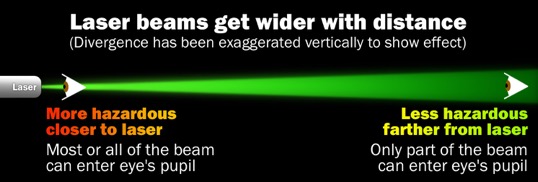
- Official accounts of eye injuries may not be accurate unless the patient has been assessed by an expert with experience in laser eye injuries. For example, if the injury passes the six questions listed in the "Diagnosis" section of this page.
- Often the injuries are examined by persons without experience in laser eye injuries, so they are misdiagnosed. For example, a pre-existing condition may be mistaken for a new eye injury. Or given the power of lasers in the crowd, it becomes highly unlikely that any of the lasers could cause the reported injuries.
- Sometimes a person exposed to bright laser light will rub their eyes too hard. This rubbing can scratch the cornea, which is the clear outer surface of the eye. A corneal abrasion is painful but fortunately will heal within a few days. This injury is not directly caused by the laser light. The clear cornea was not affected by the visible laser light. What is of concern is the light-absorbing retina, where actual damage can occur.
We often see press reports of pilots and others where it is incorrectly claimed that visible laser light damaged a person's cornea. Actually, it is the post-exposure rubbing that caused the corneal injury.
There is a report of a serious eye injury to a Los Angeles police officer during a routine call (not at a protest) in July 2020. The officer was targeted by a laser aimed from a fourth-floor apartment, apparently unrelated to the original call. He reported lost vision in his right eye, migraines and balance issues for at least two months after the attack. It is not known whether the injury would be permanent. Details are here.
To get an idea of how press reports or claims about laser-caused eye injuries can be misleading or erroneous, see the section "Three publicized but not proven eye injury cases" at the bottom of this page.
-
Reported eye injuries caused by physical objects, gasses and sprays at protests
- Persons concerned about laser-caused eye injuries at demonstrations should also note that physical objects hurled at unprotected police, and weapons used by police on protesters can cause severe eye injuries including permanent blindness. Here are a few examples:
- In mid-2016, more than 570 persons went for hospital treatment after lead pellets were fired by Indian forces trying to break up protests and crowds in Kashmir. The New York Times described patients with "mutilated retinas, severed optic nerves, irises seeping out like puddles of ink."
- According to the World Health Organization, "21 people suffered permanent loss of vision because of injuries caused during the [Palestinian 'Great March of Return'] demonstrations" in the Gaza Strip. The injuries were tallied during the 21 months from March 30 2018 until December 31 2019. More on this here.
- A June 19 2020 press release from the American Academy of Ophthalmology was titled "Eye Injuries During Protests Are an Emerging Public Health Problem." The AAO called for a ban on rubber bullets used against protesters, "after more than 20 Americans across the country suffered serious eye injuries while peacefully protesting." The article had statistics about the injuries and listed other medical organizations that support AAO's statement on rubber bullets. In addition, the press release had links to stories about eye injuries during protests in Kashmir, Chile and Hong Kong.
- A July 14 2020 Washington Post report described eye injuries during protests. The paper found that on one day, May 30 2020, "eight people lost vision in one eye after being struck by police projectiles." Six were protesters, one was a photojournalist and one a passerby. According to the Post, "in three instances, video evidence undermines official accounts of what happened." The report said four additional people were also partially blinded by police during the week that included May 30. One of the persons permanently blinded, journalist Linda Tirado, sued the city of Minneapolis and unnamed police officers.
- On July 26 2020 during the Portland, Oregon attacks on the federal courthouse, journalist Trip Jennings suffered eye hemorrhaging requiring hospitalization after being shot by federal agents.
- A report called Shot in the Head, released in September 2020 by Physicians for Human Rights lists at least 30 persons shot by U.S. law enforcement officials between May 26 and July 27 2020, who suffered permanent ocular damage. This report was cited in a May 20 2021 Narratively story (also published September 2 2021 at The Guardian) by photojournalist Wil Sands, whose right eye was blinded by a tear gas canister outside the White House on May 30 2020. Sands contacted others whose eyes were damaged by police using "less lethal weapons", told their stories, and has created an internet group for persons blinded by law enforcement.
These accounts do not include deliberate irritation of eyes using tear gas or pepper spray.
The American Academy of Ophthalmology has stated that "[t]ear gas typically doesn’t cause irreversible eye injuries, but tear gas has caused serious eye injuries, including hyphema, uveitis, necrotizing keratitis, coagulative necrosis, symblepharon, secondary glaucoma, cataracts and traumatic optic neuropathy and loss of sight." -
How to protect eyes from physical injury during protests
- Police and security forces are at risk of eye injuries during protests not only from laser light, but from thrown objects. Normally such forces have eye protection, including impact-resistant glasses and/or face shields. Such protection would be selected and issued based on the anticipated threat.
Protesters, journalists and passersby have suffered eye injuries, primarily due to projectiles fired at them by police and security forces. A short list is in the section immediately above; selected detailed stories are listed here.
On June 3 2020, the American Academy of Ophthalmology (AAO) issued a press release entitled "Nation's Ophthalmologists Condemn Use of Rubber Bullets." This was followed up with an official AAO statement calling for a ban on rubber bullet use against protesters, an awareness campaign, and a report of 20 serious eye injuries from U.S. protests as of June 19 2020.Minimizing eye injuries from projectiles
In the June 3 press release AAO linked to an online article, "How to Protect Your Eyes From Rubber Bullets."
In summary, the advice is to use ballistic-rated safety glasses and goggles. Regular safety eyewear such as those found at hardware stores, will have some impact resistance (ANSI Z87.1 rating) which is better than nothing. But ballistic-rated eyewear (MIL-PRF-31013, MIL-V-43511C and/or CE EN166B) will withstand impacts of over four times the velocity of ANSI Z87.1-rated eyewear.
Goggles with an airtight seal are preferred over glasses to help protect against tear gas, pepper spray, water cannons, paintball guns (used to mark people), and dust.
AAO listed steps to take in case of an eye injury at protests. They said to protect the eye immediately as "this is a medical emergency!".- Do not touch the eye
- Do not rub the eye
- Stay upright
- Place a hard shield around eye. Even a temporary eye shield, such as paper cup or Styrofoam cup, may work in an emergency
- If the eye ruptures, the contents inside must be preserved, seek emergency room and ophthalmology consultation immediately
Minimizing tear gas eye injuries
AAO noted that "[t]ear gas typically doesn’t cause irreversible eye injuries, but tear gas has caused serious eye injuries, including hyphema, uveitis, necrotizing keratitis, coagulative necrosis, symblepharon, secondary glaucoma, cataracts and traumatic optic neuropathy and loss of sight."
They gave these tips for tear gas eye exposure:- Remove yourself from the contaminated area as quickly and safely as possible.
- Flush the eyes with lots of clean water or eyewash (available at most pharmacies).
- Remove clothing near the face.
- Seek fresh air.
- Seek higher ground (aerosolized tear gases are heavier than air).
- Blink frequently (to promote tearing).
- Do not rub eyes (may spread crystals within the eye).
- Remove contact lenses.
- Seek emergency ophthalmic evaluation.
Minimizing pepper spray eye injuries
Finally, AAO gave similar tips for pepper spray eye exposure:- Don’t touch the eye area. Pepper spray is oil-based. Touching the area will spread the oil.
- Blink to help flush the eyes.
- Flush the eyes with lots of clean water or eyewash (available at most pharmacies). A small, randomized, controlled trial compared these five treatments (Maalox, 2% lidocaine gel, baby shampoo, milk, water) and found no difference in pain relief. Milk is NOT recommended for flushing the eyes; it's not sterile.
- Wash the skin around the eyes with baby shampoo; it will breakdown the oil without irritating the eyes.
-
Ineffective ways to defend against lasers at protests
- Elsewhere on this page, we discuss how to defend against laser attacks at protests. These ways include anti-laser visor strips and anti-dazzle eyewear.
Sometimes well-meaning persons make proposals intended to reduce the number or effect of laser pointers used at protests. Unfortunately, these methods are unlikely to be effective:- Some have suggested making mirrored visors or face shields. It is expensive to coat a large expanse of plastic with a mirror coating plus protective overcoat. Even if done, the coating will reduce the amount of light coming in through the visor or shield. It would be like wearing mirrored sunglasses. In general, the more light that is reflected, the more light that does not pass through the coating.
- Because visors or face shields are rounded, mirroring will not reflect laser light back to the person holding the laser. Fortunately, the curvature will spread the light out more so a laser beam bouncing off a mirrored visor or shield would be unlikely to hurt others. If the visor or face shield was flat, then it would be reflecting the laser in a different, essentially unknown direction.
- For various reasons, putting a retroreflector on a target (e.g., an officer's helmet or clothing) would bounce some of the beam light back to the laser but would not have the intended effect of returning the laser beam's full power (irradiance) to the source.
- Making laser pointers illegal to import or own would not be effective, at least in the short term (a few years). Protesters obviously would continue using newly-illegal pointers if they felt it was effective. In countries such as Australia where pointers were made illegal due to persons aiming at aircraft, the rate of lasing aircraft actually went up significantly after the ban. And there were other unintended negative effects as well. For more information, go to the page "What should be done about laser pointers" and read the section "…but don't rely on a laser ban (alone) to prevent laser misuse".
-
Laser pointers vs. handheld lasers
- In the laser safety field, there is a distinction between laser pointers and handheld lasers:
- The term "laser pointer" technically means low-powered handheld lasers which are legal to sell, buy and/or use for pointing purposes in a particular jurisdiction.
- Handheld lasers may look and operate like laser pointers, but they are more powerful than those legally allowed to be sold, purchased and/or used as pointers.
To give an example, in the U.S. it is illegal to manufacture, distribute or sell a laser 5 milliwatts or more as a "laser pointer" or for pointing purposes. But it is legal to manufacture, distribute or sell a handheld laser 5 mW or more as long as it has the proper labeling and safety features. (And, under federal law, anyone in the U.S. may own a laser of any power. A few states and localities may have some restrictions on laser possession.)
The reason this is important in the context of protests is that a laser pointer (defined as being less than 5 mW or 1 mW depending on the country) usually can do little or no harm to eyes or cameras. However, handheld lasers can be hundreds or thousands of milliwatts and could harm eyes and ruin camera sensors.
Since the press usually calls any handheld laser a "laser pointer", it may be futile to invoke this distinction. But the public should know that low-powered pointers like those sold for presentations and playing with pets (less than 5 mW) are relatively much safer than high-powered handheld lasers (50-2000 mW) often used in protests. -
Are lasers "offensive weapons"?
- As to whether laser pointers should be classed as "offensive weapons," that would depend on the potential or intended use.
To give an analogy, kitchen knives are widely available and are not considered to be weapons when used at home for cooking or cutting objects. But if a person carries a kitchen knife to a rally — or worse, pulls it out and aims it towards an officer — then it could be considered as an "offensive weapon."
In addition, the nature of the "weapon" should be considered. If a person has a butter knife on them (e.g. a legal 1 or 5 mW laser pointer), this is different than having a steak knife or carving knife (a higher powered handheld laser).
Finally, the nature of the target should also be considered. If cameras are important to police, and they can be blocked or damaged by laser light, then this could also be considered as "weapon" use. The intent is to deny police one of their crowd control tools. (As to whether surveillance camera information is misused, that is a political question that might differ in each case or jurisdiction.)
In November 2019, a chief magistrate in Hong Kong ruled that a laser pointer was not inherently an offensive weapon, but could become one depending on the circumstances and intent.
On September 4 2020, the Los Angeles Police Department police chief sent a memo to officers saying "The use of a laser itself shall not presumptively constitute a threat that justifies an officer's use of deadly force" (emphasis in the original). The memo added that "[i]f confronted with a laser, personnel shall utilize concepts found in Use of Force, Tactics Directive 16, Tactical De-escalation Techniques."
Here is a potential "weapon" use: In November 2019 in Chile, demonstrators aimed dozens of laser pointers at a drone, thought to be a police surveillance drone. Video shows the drone waver and eventually fly or drop to the ground. It is not known if the drone's camera sensor was temporarily or permanently blinded causing the drone pilot to lose control, or whether the pilot decided to land the aircraft. Either way, the demonstrators were successful in stopping any surveillance. (Details and links here.)
On the other hand, if lasers are used simply to make a dramatic point, such as aiming them at a building, this is not a "weapon" but instead goes back to the purpose of a laser pointer: to point out or draw attention to objects of interest. This assumes the lasers are not deliberately aimed at occupied windows or cameras on a building, but are just used to make patterns on a building as shown below.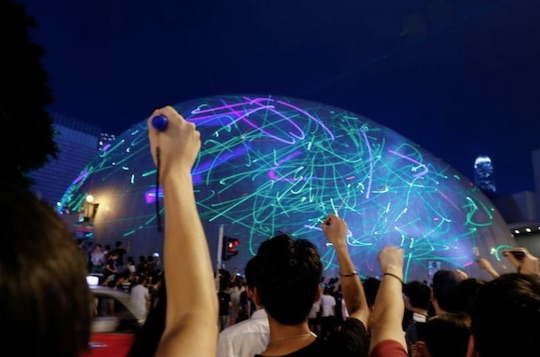
-
Use and misuse of the NOHD to determine laser hazard distances
- Sometimes police or press accounts will reference scientific descriptions of laser safety, such as the "Nominal Ocular Hazard Distance" or eye safety distance
For example, a very low-powered 1 milliwatt laser pointer has an NOHD of 23 feet (7 m) while a powerful 100 mW handheld laser has an NOHD of 230 feet (70 m). These non-experts will then imply that the laser light can cause eye damage 23 (or 230) feet away.
But this misstates the NOHD concept.- First, there is actually a safety factor built into the NOHD. It is conservative, so a person could be well within the NOHD (closer to the laser) before any detectable change happens to the retina.
- Second, the NOHD is based on experiments where the laser and the target (a monkey's eye) were fixed in place. This is not the same as in a protest situation where the laser and target are moving relative to each other (further spreading out the laser beam's heat).
- Finally, the NOHD was determined based on the smallest visually detectable change to the retina. It is likely that such a small injury would not normally be noticed, or would heal just as small skin burns heal.
Under laboratory conditions (fixed laser and target at close range), at about 1/3 of the NOHD there is a 50/50 chance of causing the smallest visually detectable change to the retina. This 1/3 distance is marked ED50 in the diagram below which color-codes a laser’s eye hazard: Red is a definite hazard, yellow is a potential hazard, and green is not considered to be hazardous.
Police, pilots, the press and others should not imply that eye injuries are likely to occur at the NOHD distance. Scientists do state that, if a person must be exposed to laser light, then it is considered safe to do so past the NOHD. But they do not say that at the NOHD distance, injuries are likely to occur.
As of September 1 2020, no one at a protest has had a proven serious or permanent eye injury caused by a laser beam. There have been reports of police officers with temporary flashblindness, like that from a camera flash. But this afterimage goes away without harm — just as the afterimage from a camera flash causes no permanent damage or change to the eye.
In short, laser beams are significantly less hazardous than thrown objects, incendiary devices, rubber bullets, shotgun pellets, guns, etc. which have injured both police and protesters. (This is not to say that lasers are "OK" to aim at persons at protests. No one should do this except under special conditions where the laser exposure is known such as at laser light shows that use legal, safe audience scanning, which is an entirely different and complex topic).
For more information on the NOHD and the "injury distance" ED50, see this page. -
Surveillance cameras easily damaged by lasers, but are harder to fully obscure
- IPVM, a research group focusing on surveillance cameras, tested different powers of lasers being used against three types of security cameras, from various distances.
The researchers' found it was easy to temporarily "blind" a camera since the bright laser light overwhelms the sensor's view. But it was difficult to keep the laser steady on the sensor.
In a YouTube video they said "It is very difficult for a human to train a laser on an object from roughly five feet away and further without their hands shaking off target. We found that using a clamp to clamp the laser steady to a stationary object to be the best means of consistently blinding a camera from roughly 50 feet away or further."
In terms of causing permanent damage to sensor pixels, to the whole sensor or to the lens, IPVM summarized as follows:- "Close range required: Permanent damage did not occur from distance of ~50 feet or further from the camera, regardless of the strength of the laser we tested."
- "Aiming by hand difficult: Targeting a laser towards a camera is difficult from more than ~10' away. Attaching the laser to a stationary object for aiming makes sensor damage much more likely."
Lasers used included low-powered laser pointers in the 5 milliwatt range (legal for sale in the U.S. as laser pointers) and high-powered handheld lasers. The group said the two high-powered lasers were around 30,000 mW (30 watts) but that is extremely unlikely. They probably were closer to 3,000 mW (3 watts).
The security camera sensors could be damaged at various powers and distances. But IPVM found it was much more difficult to cause permanent damage that rendered the cameras completely useless for surveillance purposes.
For more details, see the September 25, 2019 IPVM report "Lasers Impact on Surveillance Cameras Tested." -
Letter: Is this webpage too lenient to protesters?
- On September 19 2019 we received this letter via email:Your page about laser pointer protests seems to be too lenient to protesters.
The power of these laser pointers brought in Hong Kong is typically from 28mW to 912 mW; see https://www.customs.gov.hk/en/publication_press/press/index_id_1583.html
They aim their laser pointers at policemen within a distance of approximately 20m, sometimes more sometimes less. According to your info about NOHD, hazardous distance is 1/3 of NOHD, NOHD of 28-912mW laser pointers is 36-213m. 1/3 of NOHD is 12-70m. Those laser protests probably are within hazardous distance.
If a 20m attack at policemen with a 912mW laser pointer is not hazardous, then aiming at planes should not be an offence too.First, this is a thoughtful letter. The writer clearly read the page, did some hazard distance calculations, and had a good question.
We did write "In terms of causing eye injuries to police, in general lasers are not effective." (emphasis added). With more powerful lasers such as 912 mW, there is a possibility of injury. But here is why in general lasers are not effective in protests:
At 1/3 of the NOHD, there is a 50/50 chance of a laser beam causing the smallest visibly detectable change to the retina, under laboratory conditions where the laser is fixed in position and the eye also is not moving, if the entire beam is within the pupil of the eye.
Protest conditions are different:- The laser is almost always handheld and the targeted person is moving relative to the beam, reducing the time the laser is on any one spot of the retina.
- Not all the laser light may go through the pupil. Protests do not take place in total darkness. It is likely the pupil is constricted to be smaller than the 7 mm diameter assumed for laser safety purposes. This means it is harder to get the entire laser beam (which does spread out) into the pupil.
- A higher-powered laser such as 912 mW will usually have a more divergent (wider) beam than lower-powered lasers, perhaps 1.5 to 2 times the beam spread of lasers with a few milliwatts. If we change the hazard distance calculator to use 1.5 or 2 milliwatts, this brings the NOHD of a 912 mW laser down to 142 or 107 meters. The ED50 "1/3 of the NOHD" then becomes 45 or 34 meters.
- Keep in mind the damage scientists found at 1/3 of the NOHD was the smallest visibly detectable change. Such a small burn may heal and may not be noticed unless it occurs in the central vision. (Small-scale laser injuries can be difficult to confirm. For example, was there a pre-existing injury? See this page for more details.)
The example earlier on this page (in the section "Lasers at protests are unlikely to cause eye injuries") helps illustrate these points. Police used a high-powered laser at close range on a dark ink-covered part of a newspaper. After a few seconds, smoke occurred. But later a protester held up a newspaper while dozens of lasers tried to burn it but could not according to a news story.
This shows how there can be a significant difference between laboratory or controlled conditions, and real-world conditions at longer distances with handheld laser sources and targets that are unsteady, moving or can actively avoid beams.
We are certainly not encouraging persons to aim lasers at other people's head or eyes. No one should do this except under special conditions where the laser exposure is known (such as at laser light shows that use legal, safe audience scanning, which is an entirely different and complex topic).
It may be possible that with higher powered handheld lasers in a protest, a proven, documented and permanent eye injury could occur. But we do believe that, in general, lasers are not effective in terms of causing eye injuries to police.
Other protest hazards such as thrown objects, beanbag rounds, incendiary devices, water cannons, tear gas and of course bullets can cause more severe temporary and permanent injuries. For example, there is the well-known case of a woman who said she may lose an eye after being shot with a beanbag round fired by police. Other cases are here.
The writer's final question referenced aiming at aircraft. This is a different situation entirely. Here, the laser is not an eye injury hazard but instead is a bright source of light that can be a distraction, cause glare or even cause temporary flashblindness and afterimages. This is why many countries and jurisdictions have laws specifically against aiming a laser at or near aircraft. More information is here.
Thanks to the letter writer for emailing their questions and concerns. -
Are lasers the "future of protests"?
- In March 19 2020 the Harvard Political Review published an article entitled "Lasers: The Future of Protests" written by Jeremiah Kim, an undergraduate majoring in social studies at Harvard University with expected graduation in 2023.
Kim begins by rhetorically asking "…should lasers be considered as a future tool for peaceful protesters to use?"
He answers his own question: "There is evidence to suggest that lasers could revolutionize protesting around the world, but the final decision to use a laser or not is fundamentally a personal choice all protesters need to consider."
Kim then details the history of lasers used against police forces, discusses laser hazards, and asks U.S. police how they might respond to laser attacks.
Throughout the article Kim presents pros and cons of laser usage for protesters to consider:
✔︎ Pro: Lasers "present a low risk to physical objects"
✔︎ Pro: Lasers "garner media attention"
✔︎ Pro: Lasers can distract police
✔︎ Pro: Lasers can interfere with police drones
✔︎ Pro: Lasers can provide self-defense (presumably because officers or cameras may not be able to see laser-wielding protesters)
✘ Con: Lasers can cause eye injuries and are dangerous when used improperly: "Protesters naturally acknowledge and assume responsibility for the risks of using a laser"
✘ Con: Lasers can incite a police reaction
✘ Con: Lasers "can take away from the solidarity that social movements fundamentally rely on"
Kim concludes "Ultimately, the power of civil disobedience lies in a group of people standing together in absolute unity, not from any tool or weapon. Although lasers are remarkably powerful tools, they inherently leave room for irresponsible actors, accidents, and distractions. If the goal of a movement is tangible social change, protesters need to consider if the benefits of using a laser outweigh the potential costs." (Emphasis added)ERRORS AND MISCONCEPTIONS
LaserPointerSafety.com is not qualified to address the Harvard Political Review article's discussion of using lasers as a tool for political change. But we are qualified to discuss a number of factual errors and misconceptions in the article's section on laser hazards.Milliwatts vs watts
Author Jeremiah Kim refers to "the average 60 milliwatt lightbulb." He means 60 watts, which is typical for an Edison-style incandescent light bulb with a curly tungsten filament. Further, this is 60 watts of electrical power; a lit bulb emits about 57 watts of invisible heat — which is why they get so hot — and 3 watts of light. Those 3 watts are emitted in all directions.
A low-power laser pointer emits 1 milliwatt (1/1000 watt) of light in a single direction, the pencil-thin beam. In protests, often higher-power lasers are used. These may be in the 100s of milliwatts, with the most powerful being from 1000 milliwatts (1 watt) to a few watts.Why laser light is hazardous
Let's take a brief diversion to discuss why laser light can be so hazardous. The main reason is that it can be focused to a pinpoint on the retina, unlike white light which inherently cannot be concentrated as much.
For example, a 60-watt light bulb viewed at 5 meters (16.5 feet) puts a small part of its 3 watts of incoherent light energy into an image on the retina that will never be smaller than about 300-400 micrometers across. There is literally a tiny, upside-down image of the bulb on the retina.
In contrast, a 1/1000 watt laser at the same distance will have all of its coherent light energy focused into a pinpoint that is only about 2 micrometers across on the retina.
The result is that the 1 milliwatt laser's energy concentration is 18,000 times that of the 60 watt light bulb. If this tiny laser spot remains on the same retinal location for a number of seconds, it will heat up just like a hand that is held motionless over a candle flame. This would cause a retinal burn.
Or, if a much more powerful laser is used, this is like waving one's hand over a blowtorch. Heat builds up so fast that a burn occurs almost instantaneously, in less than a second.
Note that in both examples, we are talking about lasers close to a person's eye. At much greater distances a laser beam spreads out. This lowers the risk of eye damage both because 1) the power density (irradiance) is lower and 2) not all of the beam enters the eye's pupil.
Being far from a powerful laser is somewhat analogous to being far from a blowtorch. Both of these devices can cause burns close up. But as you get farther away, the energy is spread out — and in the case of the laser, not all of the beam enters the eye's pupil.
For example, if a person were to aim a blowtorch at a police officer 100 feet away, it might be warm but would not cause injury at that distance (though it still might draw a reaction from the officer — not a smart thing to do).Focusing on the retina
Back to the Harvard Political Review article. Kim states that the eye's cornea focuses laser light onto the retina. This is 2/3 true; the fixed cornea contributes 2/3 of the focusing power with the lens making the final, fine-tuning 1/3 adjustment.
He then quotes Dr. Julia Sein, a vitreoretinal specialist on laser hazards. The basics of what Dr. Sein says are true. However, there is no discussion of mitigating factors, such as how laser beams become less hazardous with distance, relative movement of the laser and target, and the duration of the exposure.
These factors mean that laser light which is hazardous to a researcher in a lab a few inches or feet away from the laser, may be a minor risk or may even be safe when used in a protest situation to aim at a person many yards or meters away. For more information see the section above, "Use and misuse of the NOHD to determine laser hazard distances."IMPORTANT CAUTION: Although laser light at long distances has a lower risk, this is not to say that laser light is completely safe, or that it should be deliberately aimed at anyone's head. Ordinary citizens, police, and other non-laser experts should never deliberately aim a laser at a person's head or eyes. The risk of injury depends on many factors, such as the laser power, divergence (beam spread), distance, steadiness, etc. Because non-experts cannot fully evaluate the risk, it is safest and most humane to keep a laser beam well away from anyone's head and eyes.Dr. Sein is correct that "even temporary exposure can cause decreased visual acuity and distortion of the central visual field." This essentially has the same effect as a bright conventional flashlight or camera flash. They can cause afterimages lasting many seconds or minutes — but these are not considered injuries.
Dr. Sein also said she feels laser retinal damage is an underdiagnosed problem. She may be right, but there are not enough studies and data to conclude whether this is true. Clearly more research is needed.Protective glasses
Kim asked Dr. Sein whether "UV protectant glasses are enough to fully protect the eye." The question and her answer are a bit muddled.
The relevant question is not about ultraviolet (UV) protection. Lasers used in protests emit visible light, not non-visible ultraviolet light. UV-protecting glass is designed to let visible light through. (There may be a small protective effect against deep blue or violet lasers in the 400 nm region.)
For a person wearing conventional prescription glasses, about 92% of the laser light will go through; roughly 8% is reflected by the glass surfaces. So prescription glasses do not significantly reduce the laser intensity.
Dr. Sein is correct that glasses and sunglasses would somewhat dim laser light. For example, a gray lens that transmits only 25% of all colors would reduce the laser's brightness to 25% of its normal intensity. Depending on the laser beam's original concentration (irradiance) this could be enough to provide useful protection, or it could be that the laser is so powerful that it still could cause injury even at 25% brightness.
Of course, a major problem is that most laser misuse against law enforcement and aircraft occurs at night — the time when police and pilots would not want to wear sunglasses.The best solution: laser-specific eye protection
The best solution is to use materials specifically designed to protect against laser light. These could be strips applied to face visors, or laser protective eyewear. The principle is to strongly reduce the specific colors (wavelengths) of the lasers that are most commonly used against police and aircraft. Usually a reduction between 1/100 and 1/10,000 is used.
This is a complex topic, in part due to the need to maintain a bright view in the other non-laser wavelengths.
Some specific eyewear information is in the section above, "How to defend against laser attacks." Additional information is on the page about pilot glare protection anti-laser eyewear.
Note that the eyewear must be developed specifically for the protest or aviation environments; do not use laboratory or industrial laser protective eyewear.Main hazard for pilots is visual interference
Kim concludes his laser hazard section by talking about the risk of laser pointers misused by aiming at aircraft pilots. Again, this paragraph confuses some ideas.
The risk for pilots is not eye injuries. Reasons are discussed at length elsewhere. The risk for pilots is that the laser may cause visual interference such as temporary flashblindness, glare or distraction.
If this happens during a critical phase of flight, such as when coming in for a landing, there could be serious consequences with loss of aircraft or life. (On the other hand, there have been almost 100,000 reported laser illuminations of civilian pilots since 2004 worldwide (as of mid-2021), with the worst consequences being a change of flight course, or when police, medical or rescue helicopter activities are interrupted.)Main hazard for police is eye injury
Police in protests are in a very different situation than pilots. In most cases, even temporary flashblindness of a police officer would not lead to catastrophic consequences. Usually there are colleagues nearby who can help out or replace an officer struggling to see.
The primary risk for law enforcement in a protest is serious or permanent eye injuries. This is because police are much closer to the laser source than a pilot would be.
There have been some claims of police officers with serious or permanent eye injuries. However, as of July 30 2020, there have no cases where persons with experience in evaluating laser injuries have verified such injuries.Comparison with police-caused eye injuries
Finally, it is unfortunate that Kim gives no attention to the opposite side of the coin: blindings and eye injuries caused by police and security forces during demonstrations. These greatly outnumber any claimed laser-caused eye injuries to law enforcement.
A list of dozens and hundreds of such police-caused eye injuries are discussed elsewhere on this page in various sections. -
Additional information
- For general laser injury news reports from LaserPointerSafety.com, see these links: aviation-related injury reports, non-aviation injury reports, other injury reports.
We have two pages describing laser beam hazards, and the possible effects and injuries; see Don’t aim at head & eyes, and If you are hit by a laser beam.
We also have an older page on the risks of lasers versus other products.
On August 8 2019, the South China Morning Post published an article, "Laser pointers are not illegal in Hong Kong, but are they weapons, and what harm can they do to people?". Most of the article is accurate, although a professor of electrical engineering did not adequately discuss the difficulty of handheld lasers causing injury in an adversarial, protest-type situation.
On March 19 2020, the Harvard Political Review published an article, "Lasers: The future of protests." This is summarized immediately above, with extensive discussion about some technical errors and misconceptions.

